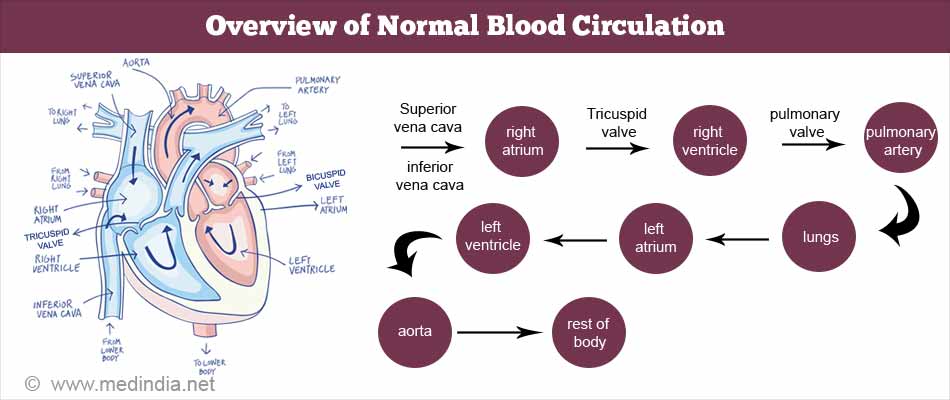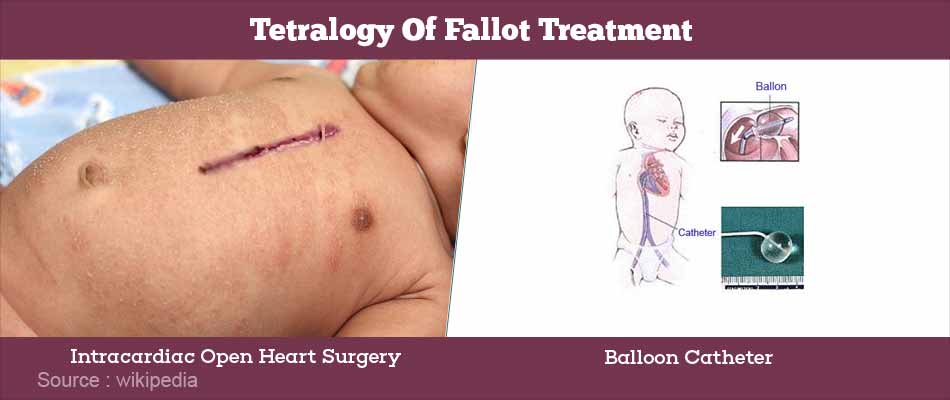- Tetralogy of Fallot: 5 Things You Should Know - (https://health.clevelandclinic.org/tetralogy-of-fallot-5-things-you-should-know/)
- What is ToF? - (http://www.chfed.org.uk/how-we-help/information-service/heart-conditions/tetralogy-of-fallot-fallots-tetralogy/)
- Fallot's tetralogy - (http://www.stanfordchildrens.org/en/topic/default%3Fid%3Dtetralogy-of-fallot-90-P01822&sa=U&ved=0ahUKEwjSsJjTqfTKAhVEShQKHbHPCsgQwW4IHDAD&usg=AFQjCNFAnJhGbheNIv2ZBNh2bZXDFIAS9w)
What is Tetralogy of Fallot?
Tetralogy of Fallot or Fallot’s tetralogy is an uncommon congenital cyanotic heart defect named after the physician who first described it in 1888. As the name suggests, Fallot’s tetralogy is composed of four heart defects occurring simultaneously. The four defects are:
- Pulmonary stenosis or narrowing of the pulmonary valve. As a result, there is difficulty in blood flow from the right ventricle into the pulmonary artery via the narrowed pulmonary valve
- Ventricular septal defect (VSD) - Hole in the wall/septum that separates the right and left ventricles. This results in mixing of impure blood from the right heart into the left heart
- Overriding of aorta - The opening of the aorta lies directly over the ventricular septal defect and this enables the right ventricle to pump deoxygenated blood directly into the aorta (which normally carries only pure oxygenated blood)
- Right ventricular hypertrophy – The right ventricular muscle becomes thickened because it has to work hard to pump blood through the narrow pulmonary valve
The end result of these four defects is mixing of deoxygenated blood from the right side of the heart with oxygenated blood on the left side leading to low oxygen content of blood and cyanosis or bluish tint of the skin and mucous membranes.
- The cyanosis usually becomes progressively worse within the first few weeks of life, and the condition is typically diagnosed quite early, although it may remain undetected for a few months or even several years.
It is an uncommon condition and occurs in approximately five out of every 10,000 births and affects both sexes equally. Around 15 percent of children with tetralogy of Fallot have a specific genetic mutation associated with other birth defects such as cleft palate.
Overview of Normal Blood Circulation
To understand what happens in tetralogy of Fallot, it is necessary to understand the events that occur in normal blood circulation
- The human heart is a four chambered organ. The two upper chambers are the right and left atria. The two lower chambers are the right and left ventricles.
- The right and left atria as well as the right and left ventricles are separated by a septum or wall.
- The right sided heart chambers contain impure venous blood and the left side contains pure blood; the wall or septum between the atria and ventricles prevents mixing of impure and pure blood
- Impure venous blood from the various organs returns to the right side of the heart
- This impure deoxygenated blood flows from the right ventricle via the pulmonary valve into the pulmonary artery and reaches the lungs
- In the lungs the impure blood gets oxygenated (from the air we breathe in) and becomes purified.
- This oxygenated blood is delivered to the left side of the heart to be pumped out to all the organs of the body via the major blood vessel, the aorta
- Once the organs use up the oxygen for their activities, the impure deoxygenated blood returns once again to the right side of the heart and the entire process is repeated
Therefore, in Fallot’s tetralogy, mixing of impure venous blood (through the VSD and overriding aorta) from the right side of the heart into the left side results in lowered oxygen concentration of the arterial blood and inadequate oxygenation of tissues. As a result, the baby’s skin and lips turn blue or cyanotic.

What are the Causes/Risk Factors of Tetralogy of Fallot?
In most cases, the exact cause of Fallot’s tetralogy remains unclear. The condition occurs when the baby is developing in the mother’s womb and may be due to a combination of genetic factors, poor maternal nutrition and viral infections during pregnancy.
Risk Factors
Certain factors that increase the chances of a baby being born with this condition include:
- Viral illness during pregnancy, such as rubella (German measles)
- Alcohol intake during pregnancy
- Mothers who take medications for seizures
- Phenylketonuria in mother
- Poor maternal nutrition during pregnancy
- Maternal age over 40 years
- Family history of Fallot’s tetralogy in parent
- Occurrence of Di George or Down syndrome

What are the Symptoms and Signs of Tetralogy of Fallot?
Fallot tetralogy symptoms vary, depending on the severity of obstruction of blood flow from the right ventricle into the pulmonary artery and the lungs. Clinical features include the following:
- A bluish coloration (cyanosis) of the skin and lips due to low oxygen content in blood
- Shortness of breath (dyspnea) and rapid, shallow breathing, especially while feeding or crying
- Fainting spells
- Clubbing of fingers and toes - abnormal, convex shape of the nail bed
- Failure to thrive and poor weight gain in the baby
- Inability to play or exercise for long periods
- Poor feeding and irritability
- Prolonged crying
- Heart murmur (sound of turbulent blood flow in the heart heard on auscultation with a stethoscope)
- Tet spells - Sudden development of deep blue tinge of skin and lips especially when the baby is agitated or during feeding or crying. This is because during these episodes, there is rapid drop in the oxygen levels in the blood. It occurs in babies between two and four months of age. Older children typically squat when this occurs when they become short of breath as squatting increases the blood flow into the lungs

What are the Complications of Tetralogy of Fallot?
Untreated Fallot’s tetralogy can lead to several complications including:
- Recurrent cyanotic spells
- Poor growth and development
- Rhythm disturbances of heart (arrhythmias)
- Seizures due to low oxygen supply to brain
- Infective endocarditis (infection of the inner lining of the heart) and clot formation
- Brain stroke and cerebral abscess due to emboli (a blood clot that is carried to other sites from its site of origin)
- Pulmonary embolism
- Sudden cardiac death
How do you Diagnose Tetralogy of Fallot?
History - Fallot’s tetralogy may be suspected when the doctor or observant parents notice bluish discoloration of the baby and seek medical attention. Older children may report episodes of fainting and breathlessness, especially on exertion
Physical examination – There may be an abnormal sound of blood (heart murmur) rushing through the narrowed pulmonary valve. Respiratory rate may be increased.
Blood tests (pulse oximetry) – a sensor placed on the finger or toe can detect oxygen saturation of the blood which will be low.
Chest x-ray – This will reveal a boot shaped heart due to enlargement of right ventricle.
Electrocardiogram (ECG) – In an ECG electrodes are placed on the chest and limbs to measure the electrical activity of the heart. It may reveal any rhythm disturbances as well as presence of enlarged right ventricle
Echocardiogram – This is an ultrasound test of the heart that employs high frequency sound waves to produce images of the heart. It will demonstrate abnormalities of the heart including blood flow through the heart, presence of VSD, enlarged right ventricle and overriding of aorta. This test will help the doctor plan treatment
Cardiac catheterization – In this test, a thin flexible tube is introduced into the thigh artery and guided into the heart. Once the tube is in the heart a contrast dye is injected to highlight the heart structure clearly and presence of any defects. The test also measures oxygen levels and pressures in the chambers of the heart and in the blood vessels. The results of the test will help the doctor decide on the course of treatment.
How is Tetralogy of Fallot Treated?
Tetralogy of Fallot is effectively managed only through surgery. Surgical options include open heart repair or a temporary shunt procedure. However, most babies and older children have definitive open heart repair.
Intracardiac Open Heart Surgery
This involves stopping the heart during the procedure. It is usually done during the first year of life and includes several repairs. Occasionally, adults with tetralogy of Fallot may undergo this procedure if it was not corrected when they were children. The various corrective procedures include:
- Placing a patch over the ventricular septal defect to close the hole between the right and left ventricles.
- Replacement the narrowed pulmonary valve and widening the pulmonary arteries to increase blood flow to the lungs.
Following the procedure, the enlarged right ventricle returns to its normal thickness and oxygen levels in the blood improve with reduction of cyanotic spells and breathlessness
Temporary Shunt Procedure
Sometimes babies need to undergo a temporary (palliative) procedure before having open heart surgery in order to improve blood flow to the lungs. This procedure is done if the baby was born prematurely or has poorly developed (hypoplastic) pulmonary arteries. The surgery is carried out from the side of the chest and the heart is not stopped
- During this operation, the surgeon creates a bypass (shunt) to divert blood from a large artery that branches off from the aorta into the pulmonary artery to increase blood flow into lungs
- Another method of increasing blood flow to the lungs is to use a balloon catheter. A balloon is introduced into the narrow portion of the pulmonary artery, and then inflated to stretch the pulmonary valve and part of the pulmonary artery below it.
When the baby is ready for intracardiac repair, the surgeon reverses the shunt created during the open heart surgery for definitive repair.







